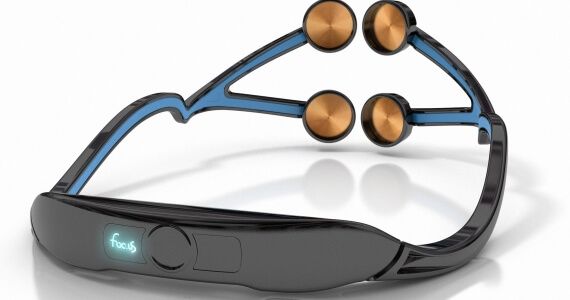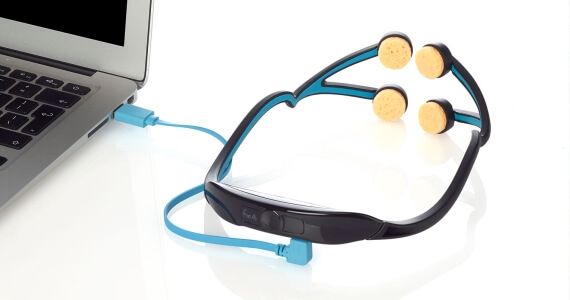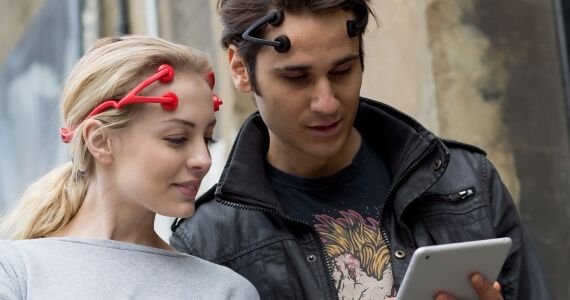Picture it: professional gamers prepare themselves for competition by selecting their perfectly customized accessories, gamepads, and headphones. But before they sit down to play, they first place a plastic halo on their heads to send a small electrical current through the front of their brain, increasing activity and heightening awareness for the intense gaming to come.
That isn't some strange vision of the future concocted by a video game peripheral company, but the promise made by the manufacturers of the Foc.us Headset. Harnessing the technology of transcranial direct current stimulation (tDCS), the makers claim that it holds the potential to take gamer awareness to a new level, and now that we've had our chance to thoroughly test the device ourselves, there might just be something to it.
For those who tend to dismiss these kind of 'gadgets' as gimmicks using pseudo-science to part the gullible from their dollars, it's important to note that transcranial direct current stimulation is a very real form of brain stimulation. The basic science is simple enough: send a low electrical current from one side of the brain to the other, exciting the surrounding neurons as a result. The developers claim that the resulting effect is an "increase working memory, vigilance, and focus" - essentially, a higher sense of awareness. Since those skills can make all the difference in the realm of video games, it isn't hard to see how the Foc.us Headset can be marketed.
The technology and headset built to utilize it may sound experimental, but the Foc.us Headset doesn't appear to be a 'prototype' in any part of its design. Constructed from light but durable plastic in a range of colors, the headset is, surprisingly, as intuitive and straightforward as gadgets can get. Shipping with the main headset frame, a set of sponges, small water bottle and USB charging cable, it's clear that the manufacturers have done everything in their power to get people using the device without intimidation, and with a styling that should be expected from its USD $249 price tag.
Understanding the intricacies of tDCS is far more difficult than operating the Foc.us, with all of its settings accessed through a single touch sensor placed on the rear of the headset. Users can choose between a set of patterns (sending current in waves, pulses, constant or random doses), and the maximum current (ranging from 0.8 mA to 2.0 mA). Once the settings are chosen, using the headset is as simple as placing the moistened sponges into the two nodes on either side of the forehead, and positioning the device as instructed in the user's manual.
The manufacturers warn that the device can feel somewhat uncomfortable at first, but using the device should not be painful. If the concept of passing an electrical current through your frontal lobe sounds terrifying, then allow us to assuage those fears by saying that while the flow of current may feel akin to a pinch or light burn, it is far from painful.
The feeling of discomfort will rise with the frequency and amount of the current selected, but the cycle can be aborted at any time with the press of button. Once the cycle has automatically completed (after 10 minutes), simply remove the headset, and commence gaming. Your brain, as the minds at Foc.us claim, will be primed for performance.
For our testing, we used the device in tandem with the likes of Resident Evil 4: Ultimate HD Edition (see the results for yourselves in our gameplay video), Titanfall and Dark Souls - three games which all rely on reaction time, spatial awareness and critical thinking in vastly different ways. And to our surprise, the effects of the Foc.us were not only noticeable, but fairly consistent.
The clearest example of the device's effects came upon sitting down to plow away at our review of RE4: Ultimate HD Edition - a game requiring far more alertness than the clouded mind that had brought me to a few swift deaths. A small break to run through one of the Foc.us' tDCS cycles, and grasping the infamous tank controls the game requires to succeed was noticeably easier. The same was true for the other games (less so for Titanfall, but the Foc.us is only meant to stimulate, not work miracles), with the frustrating demands of Dark Souls not quite as obtuse or confusing as they were prior to a Foc.us session.
Obviously, the only evidence we can offer is anecdotal. Whether the placebo effect took over in helping access the twitch skills and confidence instead of the Foc.us (and in the end, improvement is improvement), the general feeling of alertness was indisputable. And those looking for more empirical evidence aren't likely to find it: Foc.us has not been FDA-approved, since it offers no medical promises or treatment. But our experience is clearly not uncommon, given how many scientists are trying to understand what benefits tDCS may hold.
For their part, Foc.us warns against overusing the device (more than once every 48 hours), and to stay away from the treatment if you have suffered from epilepsy or other brain afflictions. While Foc.us clearly states that the device is only intended to improve video game performance, it has to be said that in our testing, a subject with nerve damage found that the headset returned some feeling to the afflicted limb during use (Editor's note: Foc.us makes no such claim that the headset can or should be used for these ends, a sentiment we fully agree with).
Nevertheless, all these experiences prove that whatever the specifics, there is clearly something to tCDS technology. So for those wishing to experience the stimulation firsthand, Foc.us has created a solidly-built, and intuitively designed consumer version. The price tag is no doubt a premium one, but with technology this experimental, it's to be expected.
We obviously can't speak to the safety or long term effects of this treatment, but our experience with Foc.us and gaming speaks for itself.
For more information on the Foc.us Headset, or to order one yourself, head on over to the company's official website.
_____
Follow Andrew on Twitter @andrew_dyce.



